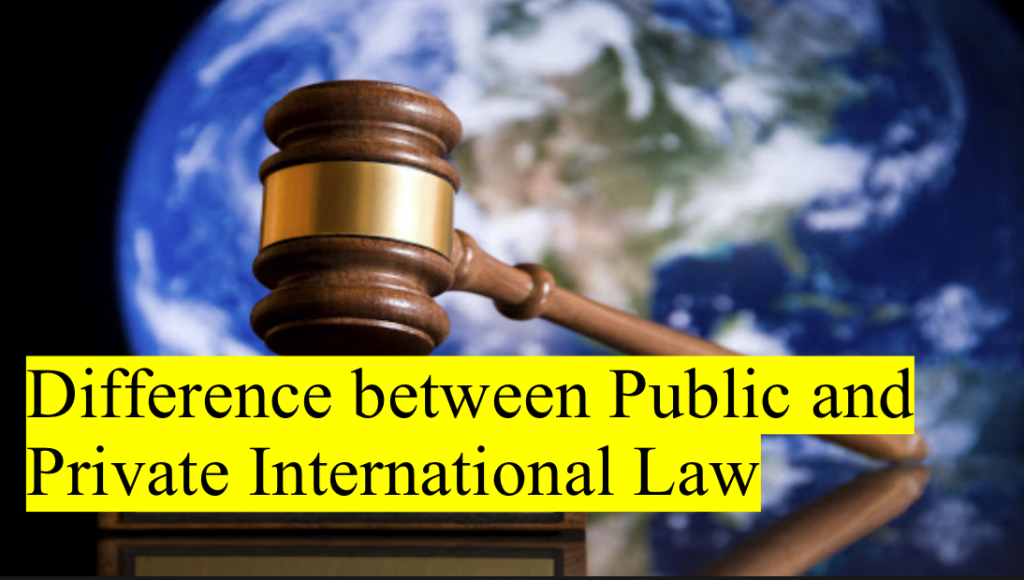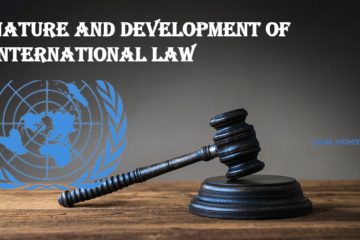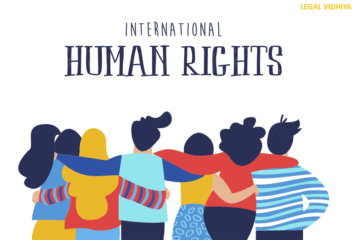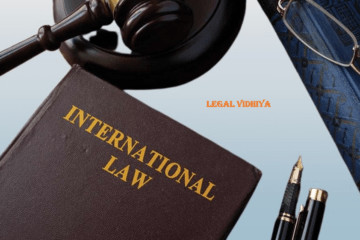
Difference between Public and Private International Law
Abstract
The rules governing the relations and conduct of sovereign states with one another are the subject of international law, which is also known as the “law of nations.” International law is divided into private and public international law. This research article talks about private and public international law in terms of the difference, nature ,scope and theories as well. . It helps the readers get a clear idea of what comes under what law and what theses laws in particular deal with and who all are accountable to which law. An in detailed analysis of both the laws are discussed to get a proper understanding and knowledge.
Keywords: Law, Private, Public, International , Jurisdiction
Introduction
It is important to know in the start as to what is private and public international law in general sense . Private International Law is that piece of the law of any State which comes into activity when a court is called upon to decide a suit containing an unfamiliar component. The private person, also known as an individual, is the primary focus of private international law. Consequently, the Law of Conflict is another name for international private law. When a private person and the Sovereign State are at odds, these private international laws are used. Private International Law administers the decision of regulation to apply when there are clashes in the homegrown law of various nations connected with private exchanges: which jurisdiction governs the selection of a court, the transfer of proceedings, and the recognition or enforcement of a foreign judgment. Private International Law is primarily derived from national laws. The fields of private international law include international contracts, torts, family law, the recognition of judgments, and child adoption.
Public International Law on the other hand deals with the primary subject , the State which is the Country. As a result, the Law of Nations is also used to refer to international public law. The body of legal guidelines used by the Sovereign States and other international authorities is what constitutes public international law.
Jus gentium, or the Law of Nations, was a set of rules for how sovereign states dealt with one another. Public global regulation is fundamentally worried about the relations between sovereign States but on the other hand, is exposed to people and associations in the States. The subjects of public international law operate within a common framework that is established by public international law norms, which also contribute to the general stability, organization, and consistency of international relations. Additionally, relations between States and non-State actors are governed by public international law; individuals, international organizations, and multinational corporations, for instance, Public International law gives each person rights, and it’s important to remember that international law doesn’t stay the same. It is developing. Diplomatic relations (diplomatic law) are just a few of the many areas in which international law can be applied. investment and trade; people’s treatment (the law on human rights).
Objectives
Understanding these distinctions is significant in light of the fact that it assists people and organizations with exploring the intricacies of managing worldwide exchanges and connecting with unfamiliar general sets of laws. Additionally, it provides guidance for the creation of international legal frameworks and institutions aimed at fostering international cooperation and justice. The research article deals with the following objectives mentioned below:
- To get a proper understanding of the difference between the laws.
- To compare and analyze the principles, concepts, and doctrines that set public international law apart from private international law.
- To investigate the sources, strategies, and people who were involved in the creation, interpretation, and application of private and public international law.
- To assess the viability, proficiency, and authenticity of private and public worldwide regulation in tending to worldwide difficulties, like transnational wrongdoing, ecological corruption, and financial disparity.
- To propose potential reforms or solutions to the gaps, ambiguities, and conflicts in private and public international law.
- To offer policymakers, practitioners, and academics suggestions for improving the consistency, coherence, and coordination of private and public international law.
Analytical comparison between Private and Public International Law
Nature of Law
- The relationships between states, international organizations, and other entities with international legal personality are the focus of public international law. The use of force, diplomatic immunity, human rights, international trade, and the rights and obligations of states in their interactions with one another are all governed by it. Public international law is generally regarded as customary or treaty law because it is binding on all states.
- Private international law, on the other hand, deals with the legal relationships that exist between private individuals, businesses, and other entities that conduct business in other countries. It addresses issues like the recognition and enforcement of foreign judgments, the choice of law, and jurisdiction. Although states are not bound by private international law, national legal systems recognize it as a set of rules and principles that govern cross-border transactions.
- As a result, private international law and public international law have distinct legal bases, guiding principles, and enforcement mechanisms. While private international law is based on national laws, international conventions, and comity principles, public international law is primarily based on treaties and customary practices. Private international law is enforced through domestic courts and arbitration, whereas public international law is enforced through diplomatic channels, international courts and tribunals, and economic sanctions.
Scope of the Law
The resolution of legal conflicts and the provision of certainty and predictability to parties involved in cross-border transactions is the scope of private international law. It aims to prevent conflicts between the various legal systems that apply to a given dispute by providing a framework for harmonizing them. It covers a variety of legal topics, including:
- Jurisdiction: The authority to hear a case involving parties from multiple nations is determined by private international law.
- Choosing the law: Confidential worldwide regulation lays out rules for figuring out which overall set of laws or regulation applies to a given question that includes parties from various legitimate wards.
- Enforcement and recognition of foreign judgments: Confidential global regulation sets out the circumstances under which unfamiliar decisions can be perceived and upheld by public courts.
Public international law covers a wide range of international relations and global governance topics. Public international law covers a wide range of important topics, including:
- State sovereignty : Public global regulation manages the connection among states and their sovereign privileges and commitments. It addresses issues like the use of force, the creation and termination of treaties, and the recognition of states.
- International human Rights: A framework for international human rights protection is provided by public international law. It establishes international institutions to monitor and enforce human rights standards and norms for the treatment of individuals, including refugees and asylum seekers.
- International Trade: State and international organizations’ actions in the areas of trade and investment are governed by public international law. Intellectual property rights, trade barriers, tariffs, and investment protection are all addressed.
Sources of the law
National Laws are the essential wellsprings of Private International Regulation, but at the same time are epitomized in settlements and shows, model regulations, lawful aides, and different instruments that control exchanges.
The ways in which legal rules and principles are established and recognized in cases involving cross-border transactions or foreign elements are the sources of private international law, which is also known as the conflict of laws. The following are the primary sources of private international law:
- National Laws: The rules of private international law are primarily derived from national laws, which may vary from nation to nation. Private international law rules are part of each nation’s legal system, which can be codified in national statutes or developed through case law.
- International Conventions : For certain areas of private international law, such as international trade, international arbitration, or family law, international conventions or treaties may provide uniform rules or principles. The Hague Convention on the Civil Aspects of International Child Abduction and the New York Convention on the Recognition and Enforcement of Foreign Arbitral Awards are two examples of such conventions.
- Modern laws and guidelines: Worldwide associations, for example, the Unified Countries Commission on Global Exchange Regulation (UNCITRAL) have created model regulations and rules on specific parts of private worldwide regulation.
The wellsprings of public worldwide regulation are the manners by which legitimate standards and standards are laid out and perceived at the global level. The following are the primary sources of public international law:
- Treaties: Written agreements that impose legal obligations on the parties are known as treaties. They are signed by states or international organizations. They cover a wide range of topics, including human rights, international trade, and the environment, and are one of the most important sources of international law.
- International law as a rule: States have accepted and followed unwritten rules and practices that make up customary international law over time. These rules are considered legally binding because they are the result of states’ consistent and widespread practice.
- General legal principles: Legal principles that are recognized by national legal systems and also apply internationally are referred to as general principles of law. They include concepts like the right to a fair trial and the prohibition of discrimination.
Theories
Private International law is an ever-evolving and complicated field that is shaped by a variety of theoretical perspectives. Private international law’s main theories are as follows:
- Theory of territory: According to this theory, regardless of the parties’ nationality or place of residence, any legal disputes that arise within its borders ought to be subject to the laws of that country. Under this hypothesis, confidential global regulation is seen as a bunch of decisions that figure out which country’s regulation applies to a specific debate.
- Choice of Law Theory: Parties to a dispute should be able to choose which law applies to their case, according to this theory. To put it another way, private international law ought to be adaptable enough to permit parties to choose their preferred legal system over that of the nation in which the dispute originated.
- Theory of harmonization: Global legal harmonization and the creation of uniform rules that apply to all jurisdictions are emphasized in this theory. The goal is to establish a legal framework that is more predictable and consistent for cross-border transactions, which may assist in lowering the likelihood of disagreements and conflicts.
The following are some relevant theoretical perspectives for the study of public international law:
- Theory of natural laws: According to this theory, there are fundamental rules of right and wrong that do not depend on human law. As per regular regulation scholars, these standards ought to direct the turn of events and understanding of public worldwide regulation.
- The positivist view: The theory places an emphasis on the significance of state practice and state consent in the formation of public international law. International law, according to positivists, is established by states’ behavior and actions, either explicitly or implicitly.
- Realist Theory: Power and self-interest play a significant role in the development of international law, according to this theory. Realists contend that states are the primary actors in the international system and that the distribution of power among these states is reflected in international law.
Drawbacks
Downsides of private international law:
- Lack of consistency: The majority of private international law is still based on national laws and legal systems, which can be very different from one country to the next. This absence of consistency can make it challenging to anticipate the result of cross-line debates and can prompt irregularities in the use of the law.
- Complexity: Non-specialists may find it challenging to comprehend and apply private international law because of its technical complexity. Cross-border disputes can also take more time and money to settle because of this complexity.
- Restricted scope: The resolution of disputes between private individuals or businesses is the primary focus of private international law, which does not address more general issues of public policy or international relations.
Negative aspects of international public law:
- Inability to enforce: There is no world government or an international court with the authority to enforce international law, so public international law is largely based on voluntary compliance. This can hinder the effectiveness of international law in resolving disputes and make it more difficult to ensure compliance with international legal standards.
- Power imbalances: Public international law is frequently criticized for reflecting the international system’s power imbalances. Smaller and weaker states may have limited influence over the creation of international legal norms, whereas wealthier and more powerful states frequently can shape international law to their advantage.
- Slow development: Public international law is frequently criticized for its slow development and the inability of international legal institutions to keep up with rapidly evolving global issues like terrorism, cybercrime, and climate change.
Case Laws Involved
Private International Law
A classic illustration of a private international law case is the landmark Hilton v. Guyot case from 1895. Two French citizens were at odds in the case over a contract that was governed by French law. In the case, the US Supreme Court decided that the French judgment should be enforced in accordance with US law and that it was entitled to full faith and credit in the United States.
The issue of forum selection clauses in international contracts was addressed by the US Supreme Court in the 1972 case Bremen v. Zapata Off-Shore Co. The Court decided that, as long as they are not the result of fraud or unequal bargaining power, such clauses are generally enforceable.
Public International Law
The instance of Nicaragua v. US (1986) involved a disagreement regarding US support for the Contras in Nicaragua. By supporting the Contras and mining Nicaragua’s harbors, the United States of America had broken international law, according to the International Court of Justice (ICJ).
The instance of Prosecutor v. Tadic (1995) was the principal case heard by the Worldwide Criminal Court for the previous Yugoslavia (ICTY). During the Bosnian War, there were allegations of war crimes and crimes against humanity. International crimes like genocide, war crimes, and crimes against humanity can now be prosecuted under the legal framework that was helped to be established by the case.
Suggestions to improve
Increasing consistency: There is a need to increment consistency in confidential global regulation to make it more unsurprising and steadier. This could be accomplished through increased cooperation between national legal systems and the creation of internationally recognized legal instruments like model laws or treaties.
Simplification: Access to justice can be hindered by the technical and intricate nature of private international law. The law could be simplified to make it easier for non-specialists to understand and reduce the cost and time required to settle cross-border disputes.
Concentration on mediation: As a means of resolving disputes in private international law, mediation should be promoted because it has the potential to be both cost-effective and effective.
Strengthening legal institutions: The strength of international legal institutions is crucial to the efficiency of public international law. As a result, efforts ought to be made to improve these institutions’ capacity to enforce international legal norms, such as the International Court of Justice (ICJ) or the International Criminal Court (ICC).
Getting rid of power imbalances: Endeavors ought to be made to address the power uneven characters that exist in the worldwide framework and guarantee that all states have an equivalent say in the improvement of global lawful standards.
Conclusion
In conclusion, cross-border activities are regulated and international cooperation is encouraged in significant ways by private international law and public international law, two distinct areas of law. Public international law deals with the relationships between states and international organizations, including the enforcement of human rights and the prevention of armed conflicts. Private international law focuses on resolving conflicts between private parties involving foreign elements, such as contracts or torts. There are difficulties in both private and public international law, including a lack of uniformity, complicated procedures, and limited enforcement mechanisms. However, efforts are being made to overcome these difficulties by strengthening international legal institutions and enhancing cooperation between legal systems. The turn of events and advancement of elective debate goal systems, like intervention, can likewise add to more proficient and practical goal of questions. In general, the global legal system relies on private and public international law, which collaborates to advance peace, stability, and justice.
References
- What is public international law? – Public International law (wordpress.com)
- Difference Between Public International Law and Private International Law / Law of Conflicts – SRD Law Notes
- Briggs, A. (2018). Private international law in English courts. Oxford University Press.
- Fisher, S. (2015). Private international law and public international law. In Private International Law in Commonwealth Africa (pp. 22-38). Springer.
- Klabbers, J. (2013). An Introduction to International Institutional Law. Cambridge University Press.
Written by Merwin Emmanuel Richard




0 Comments